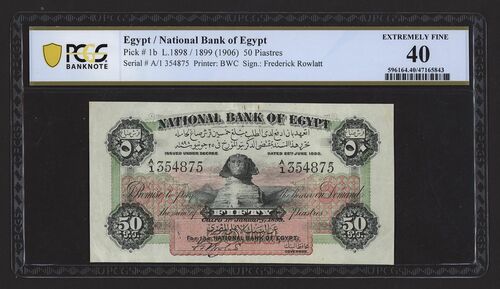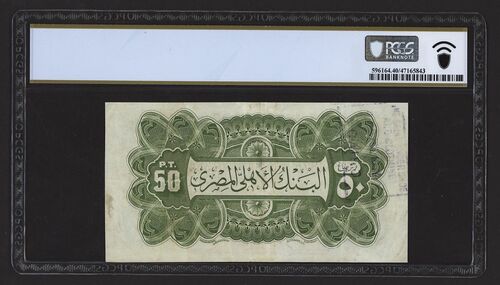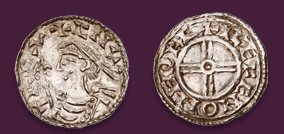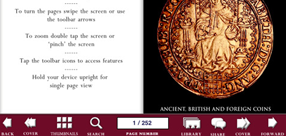Auction: 23231 - World Banknotes - e-Auction
Lot: 79
National Bank of Egypt, 50 Piastres, 21st January 1899, serial number A/1 354875, in 1867, Egypt found itself within the Khedivate of Egypt, an autonomous Ottoman province lasting until 1914. This period was characterised by a succession of Khedives, rulers with nominal authority under the Ottoman Sultan. Khedive Ismail Pasha notably spearheaded sweeping modernisation efforts, directing his ambitions towards revitalising Egypt's infrastructure and economy.
The British became increasingly influential in Egypt as the late 19th century unfolded. They had taken occupation of the region by 1882, ostensibly to quell political turmoil and restore order. This occupation, however, marked the beginning of effective British control over Egypt's financial systems, infrastructure, and administration.
The National Bank of Egypt was formed in 1898 against this backdrop of British influence. The venture was a collaboration between British and Egyptian stakeholders, with British investors holding the prominent role. Its mission was to provide financial services and contribute to economic development within the region.
The 1899 series, authorised by a decree on 25th June 1898, coincided with the establishment of the National Bank of Egypt and was entrusted to the British firm Bradbury, Wilkinson & Co.
Within the realm of early Egyptian banknotes, the 1899 series presents a unique opportunity for collectors to acquire two specific denominations: the 50 Piastres and the 1 Pound. These notes hold a special distinction as they are considered rare finds in the market, with sightings infrequent in any condition. Contrastingly, while having been officially issued, the higher denominations are primarily known to exist in specimen form making them seldom available for sale.
This 50 Piastres note features a magnificent depiction of the Great Sphinx of Giza on the obverse face. The Sphinx, one of the world's most renowned landmarks, is a colossal statue with the body of a lion and the head of a Pharaoh, often associated with Pharaoh Khafre. This marvel of ancient Egyptian art and engineering traces its origins to the Old Kingdom period, around 2500 BC, and has fascinated the global community with its enigmatic presence as the guardian of the Giza Plateau and the pyramids for millennia, and remains an enduring symbol of Egypt.
This note is signed by Sir Frederick Rowlatt
(Pick 1b, Hanafy M1, BNB 101), in PCGS holder 40 Extremely Fine, survivors from this era are exceedingly rare and highly sought after by collectors, especially in such an incredible grade and without any remarks, an exceptional rarity
Subject to 20% VAT on Buyer’s Premium. For more information please view Terms and Conditions for Buyers.
Sold for
£30,000
Starting price
£5000







